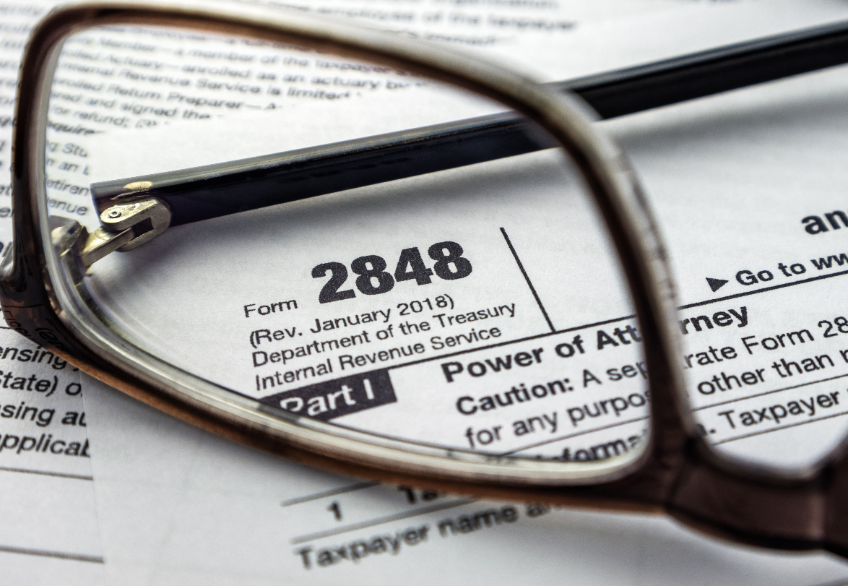
I didn’t realize there was a form for this!
The 2848 form is an Internal Revenue Service (IRS) document used to authorize a third party to represent an individual when filing income tax returns or making inquiries with the IRS. It is also known as a Power of Attorney and Tax Information Authorization form. This form grants broad powers to the designated person in order to handle the taxpayer’s tax matters on their behalf. The authorization can be either for one-time or specific use, or it can be unbounded allowing the third-party representative access to all tax information.
The form also allows for authorizing individuals who are unenrolled return preparers, so that they may file basic federal tax returns, but not for e-filed returns or copies of previously filed returns. The power of attorney must accompany any return that was not prepared by the taxpayer themselves. Additionally, this form authorizes requests for transcripts of return in question and stays active until it is revoked by either the taxpayer or the representative.
What do you use Form 2848 to do?
Form 2848 is typically needed when an individual needs someone else to represent them before the IRS. This includes making inquiries, filing income tax returns, or requesting transcripts on their behalf. The form grants broad powers to the designated third party to handle all of the taxpayer’s tax matters as an agent. It can be used for one-time or specific use, or it can be unbounded allowing access to all of the taxpayer’s tax information. This form must accompany any return that was not prepared by the taxpayer themselves and is especially useful in situations where a taxpayer is unable to manage their finances due to medical conditions or advanced age.
Completing a 2848 Form
Completing a 2848 form is a straightforward process. First, the taxpayer must identify themselves by entering their name, address, and Social Security number. Then they must indicate who will be acting on their behalf by providing the name, address, and Tax Identification Number of the authorized representative. The taxpayer should also indicate what type of tax return is in question (e.g., basic income tax, copies of returns filed previously, e-filed returns, federal tax return). Finally, they must sign and date the form and provide any additional information required to complete it accurately. Depending on the type of tax return being filed and who is filing it (e.g., an enrolled agent or an unenrolled return preparer), there may be additional steps involved in completing this form correctly. In most cases, however, all that is needed is for both parties to fill out their respective portions of the document. Once completed properly, Form 2848 should be submitted to the IRS along with the applicable charge for filing.
Who Can File a 2848 Form?
The 2848 form is used to designate a representative to act on behalf of a taxpayer. This can be done in a variety of situations, including filing income tax returns, obtaining transcripts of tax returns, and making inquiries about a particular medical condition. Generally, anyone can file the form as long as they are 18 years or older and have the authority to make decisions on behalf of the taxpayer. The form must be signed by both the taxpayer and their representative who will have either broad powers or specific powers for one-time use only. A power of attorney designation allows the representative to request IRS information, make requests for hearings, submit documents on the taxpayer’s behalf, and more. It is important to note that while power of attorney agreements stay in effect until revoked by either party, they do not give representatives unbounded powers over taxpayers’ finances or other matters.
Where to Send the 2848 Form?
The 2848 form must be sent to the address listed on the form itself. Depending on the purpose of the form, it may be sent to a specific division or office within the IRS. For example, if the form is being filed in order to receive copies of tax returns or transcripts of tax returns, then it should be sent to the Wage and Investment Division. If the form is being used for a basic tax return filing or an e-filed return, then it should be sent to either Tax Exempt and Government Entities or Small Business/Self Employed divisions. It is important to note that certain forms cannot be submitted electronically and must instead be filed by mail; other forms can only be e-filed by unenrolled return preparers for taxpayers who are not eligible for IRS e-file. When mailing in a 2848 Form, taxpayers should ensure that they include all required information and double check their address before sending so that their request will not be delayed or rejected due to incorrect information.

Nick Charveron
Nick Charveron is a licensed tax practitioner and Partner & Co-Founder of Community Tax, LLC. As an Enrolled Agent, the highest tax credential issued by the U.S. Department of Treasury, Nick has unrestricted practice rights before the IRS. He earned his Bachelor of Science from Southern Illinois University while serving with the U.S. Army Illinois National Guard and interning at the U.S. Embassy in Warsaw, Poland. Based in Chicago, Nick combines his passion for finance and real estate with expertise in tax and accounting to help clients navigate complex financial challenges.







